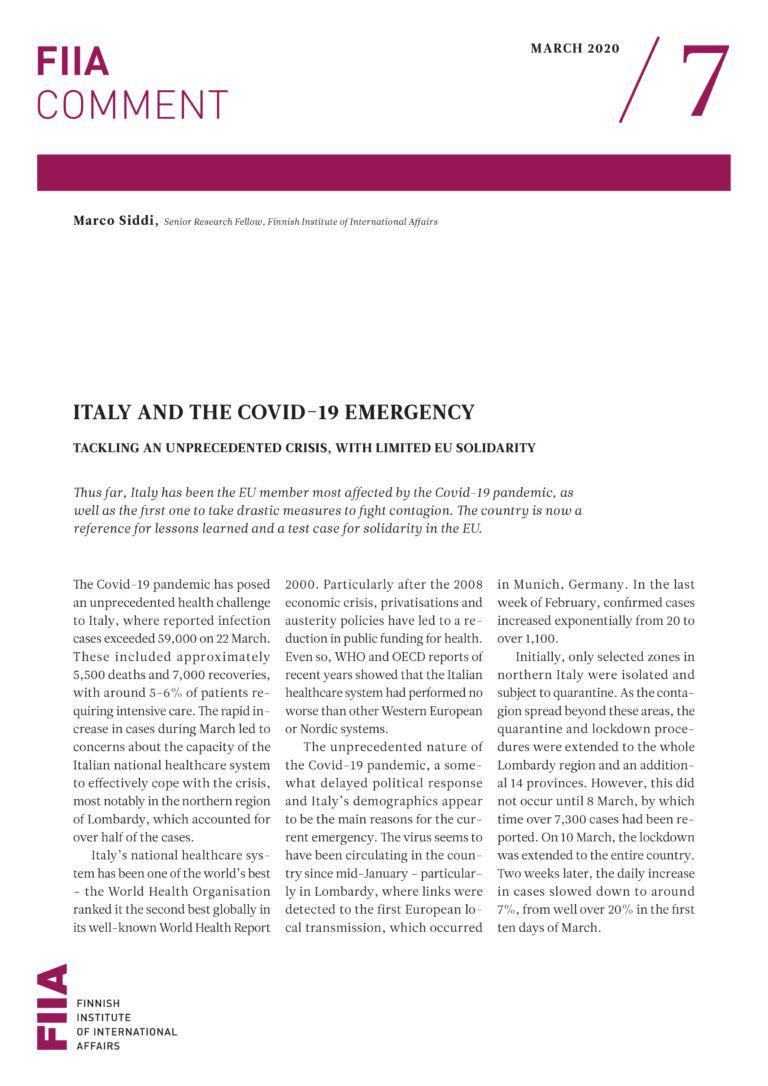Thus far, Italy has been the EU member most affected by the Covid-19 pandemic, as well as the first one to take drastic measures to fight contagion. The country is now a reference for lessons learned and a test case for solidarity in the EU.
The Covid-19 pandemic has posed an unprecedented health challenge to Italy, where reported infection cases exceeded 59,000 on 22 March. These included approximately 5,500 deaths and 7,000 recoveries, with around 5-6% of patients requiring intensive care. The rapid increase in cases during March led to concerns about the capacity of the Italian national healthcare system to effectively cope with the crisis, most notably in the northern region of Lombardy, which accounted for over half of the cases.
Italy’s national healthcare system has been one of the world’s best – the World Health Organisation ranked it the second best globally in its well-known World Health Report 2000. Particularly after the 2008 economic crisis, privatisations and austerity policies have led to a reduction in public funding for health. Even so, WHO and OECD reports of recent years showed that the Italian healthcare system had performed no worse than other Western European or Nordic systems.
The unprecedented nature of the Covid-19 pandemic, a somewhat delayed political response and Italy’s demographics appear to be the main reasons for the current emergency. The virus seems to have been circulating in the country since mid-January – particularly in Lombardy, where links were detected to the first European local transmission, which occurred in Munich, Germany. In the last week of February, confirmed cases increased exponentially from 20 to over 1,100.
Initially, only selected zones in northern Italy were isolated and subject to quarantine. As the contagion spread beyond these areas, the quarantine and lockdown procedures were extended to the whole Lombardy region and an additional 14 provinces. However, this did not occur until 8 March, by which time over 7,300 cases had been reported. On 10 March, the lockdown was extended to the entire country. Two weeks later, the daily increase in cases slowed down to around 7%, from well over 20% in the first ten days of March.
Another major concern has been the relatively high mortality rate from Covid-19 in Italy compared to other countries. To explain this, the first scholarly analyses cited the high average age of the Italian population, as well as the fact that the senior population appears to have been affected more than in other countries.
Since 8–10 March, Italians have been allowed to leave their homes only for essential needs (such as food shopping) and to perform essential work. Restrictive measures have been enforced. The vast majority of the population appears to support the restrictions and is cooperating in their implementation. These measures are due to remain in place until at least 3 April. The government has also fast-tracked the hiring of new doctors and nurses and the purchase of ventilators for hospitals.
However, important challenges remain. As hospitals in the most affected provinces are reaching maximum capacity, nationwide coordination and timing are essential. Moreover, in early March, the decision by thousands of Italians living in the north of the country to move to their families or holiday houses in the south increased the risk of accelerating contagion nationwide.
A further risk is that the disease will spread to crowded areas, such as prisons and reception facilities for asylum seekers. The focus on trying to contain the pandemic is also limiting operations to assist migrants and asylum seekers, many of whom are particularly vulnerable to the virus due to the dire conditions they have had to endure.
In this difficult context, the expectation is that EU institutions and other member states would help if necessary. This expectation also corresponds to the provisions enshrined in EU law. Article 6 of the Treaty on the Functioning of the EU (TFEU) states that the Union has the competence to support, coordinate or supplement the actions of member states concerning the protection and improvement of human health. Moreover, Article 168 of the TFEU states that the European Parliament and the Council can adopt measures to combat major cross-border health scourges.
However, the initial response of EU institutions was slow, and some member states showed little solidarity. Italy and other EU members were dismayed to learn that, in early March, France and Germany had temporarily restricted the export of masks and other protective equipment. By contrast, at the same time, China started to dispatch tons of medical equipment and teams of doctors to Italy.
Even more disappointing was the initial reaction of European Central Bank (ECB) president Christine Lagarde, while commenting on possible ECB action vis-à-vis a looming economic crisis. On 12 March, her statement that the ECB was "not here to close spreads" between the borrowing costs of member states led to the biggest single-day fall in Italian government bonds in a decade. The ECB later reversed its stance and, on 19 March, announced a €750 billion emergency bond plan to allow EU member states to increase spending to counter the impact of the coronavirus.
Italy appears to be only the first in a string of Covid-19-related national emergencies in the EU. It is therefore a test case for EU responsiveness and solidarity. As the pandemic surges in other European countries, EU institutions and member states should display solidarity and promptly react to the health emergency and the highly likely economic slowdown. Solidarity should also be extended beyond the EU, particularly to poorer countries. A pandemic can only be tackled with global measures, and wealthier states should contribute more to the common cause.







